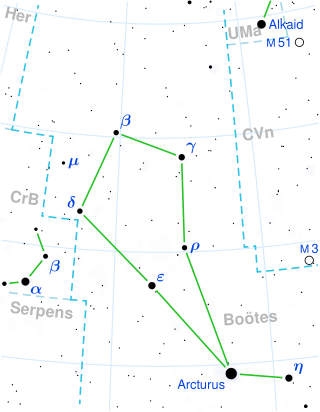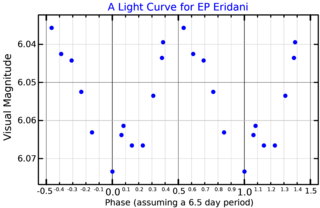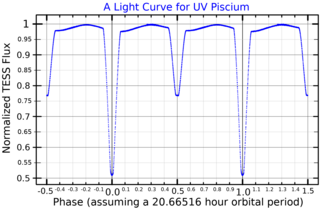
Subrahmanyan Chandrasekhar was an Indian-American theoretical physicist who spent his professional life in the United States. He shared the 1983 Nobel Prize for Physics with William A. Fowler for "...theoretical studies of the physical processes of importance to the structure and evolution of the stars". His mathematical treatment of stellar evolution yielded many of the current theoretical models of the later evolutionary stages of massive stars and black holes. Many concepts, institutions, and inventions, including the Chandrasekhar limit and the Chandra X-Ray Observatory, are named after him.

The Giant Metrewave Radio Telescope (GMRT), located near Narayangaon, Pune in India, is an array of thirty fully steerable parabolic radio telescopes of 45 metre diameter, observing at metre wavelengths. It is the largest and most sensitive radio telescope array in the world at low frequencies. It is operated by the National Centre for Radio Astrophysics (NCRA), a part of the Tata Institute of Fundamental Research, Mumbai. It was conceived and built under the direction of Late Prof. Govind Swarup during 1984 to 1996. It is an interferometric array with baselines of up to 25 kilometres (16 mi). It was recently upgraded with new receivers, after which it is also known as the upgraded Giant Metrewave Radio Telescope (uGMRT).

Monthly Notices of the Royal Astronomical Society (MNRAS) is a peer-reviewed scientific journal covering research in astronomy and astrophysics. It has been in continuous existence since 1827 and publishes letters and papers reporting original research in relevant fields. Despite the name, the journal is no longer monthly, nor does it carry the notices of the Royal Astronomical Society.

Iota Boötis is a member of a binary star system in the constellation Boötes, approximately 96 light-years from Earth. It has the traditional name Asellus Secundus and the Flamsteed designation 21 Boötis. The companion is HD 234121, a K0 main sequence star.

Omicron1 Centauri is a star in the constellation Centaurus. It is approximately 10,000 light years from Earth.

HD 17925 is a variable star in the equatorial constellation of Eridanus. It has the Gould designation 32 G. Eridani and the variable star designation EP Eri. The star has a yellow-orange hue and is dimly visible to the naked eye in good seeing conditions with an apparent visual magnitude that varies from 6.03 down to 6.08. It is located nearby at a distance of 34 light years from the Sun based on parallax, and is drifting further away with a radial velocity of +18 km/s. It is a likely member of the Local Association of nearby, co-moving stars. The spectrum shows a strong abundance of lithium, indicating that it is young star. This likely makes its point of origin the nearby Scorpio–Centaurus Complex.

Astronomy & Astrophysics is a monthly peer-reviewed scientific journal covering theoretical, observational, and instrumental astronomy and astrophysics. The journal is run by a board of directors representing 27 sponsoring countries plus a representative of the European Southern Observatory. The journal is published by EDP Sciences and the editor-in-chief is Thierry Forveille.
Govind Swarup was a pioneer in radio astronomy. In addition to research contributions in multiple areas of astronomy and astrophysics, he was a driving force behind the building of "ingenious, innovative and powerful observational facilities for front-line research in radio astronomy".
The Astronomical Society of India (ASI) is an Indian society of professional astronomers and other professionals from related disciplines. It was founded in 1972, with Vainu Bappu being the founder President of the Society, and as of 2010 has a membership of approximately 1000. Its registered office is at the Astronomy Department, Osmania University, Hyderabad, India. Its primary objective is the promotion of Astronomy and related branches of science. It organises meetings, supports and tries to popularise Astronomy and related subjects and publishes the Bulletin of the Astronomical Society of India.
Professor Hamid M. K. Al- Naimiy is Chancellor at the University of Sharjah in the United Arab Emirates as well as Professor of Astronomy and Astrophysics.

QS Telescopii is a faint, well-studied binary star system in the southern constellation Telescopium. It is composed of a white dwarf and main sequence donor star, locked into a close, circular orbit facing one another. Known as polars, material from the donor star does not form an accretion disk around the white dwarf, but rather streams directly onto it. This is due to the presence of the white dwarf's strong magnetic field. The pair undergo frequent shifts between a high and low accretion states, and it shifts between single and double accretion poles. The main pole is partially self-eclipsing.

Vijay Kumar Kapahi was an Indian astrophysicist and the director of the National Centre for Radio Astrophysics, an autonomous division of Tata Institute of Fundamental Research. Known for his research on radio galaxies, quasars and observational cosmology, Kapahi was an elected fellow of all the three major Indian science academies – Indian Academy of Sciences, Indian National Science Academy and National Academy of Sciences, India –

LQ Hydrae is a single variable star in the equatorial constellation of Hydra. It is sometimes identified as Gl 355 from the Gliese Catalogue; LQ Hydrae is the variable star designation, which is abbreviated LQ Hya. The brightness of the star ranges from an apparent visual magnitude of 7.79 down to 7.86, which is too faint to be readily visible to the naked eye. Based on parallax measurements, this star is located at a distance of 59.6 light years from the Sun. It is drifting further away with a radial velocity of 7.6 km/s.

XY Ursae Majoris is a short period binary star system in the northern circumpolar constellation of Ursa Major. It is an eclipsing binary with a baseline apparent visual magnitude of 9.50. The system is located at a distance of 221.5 light years from the Sun based on parallax measurements, but is drifting closer with a radial velocity of −10 km/s. It has a relatively high proper motion, traversing the celestial sphere at the angular rate of 0.191″·yr−1.

SZ Piscium is a suspected triple star system in the equatorial constellation of Pisces. The inner pair form a double-lined spectroscopic binary with an orbital period of 3.966 days. It is a detached Algol-type eclipsing binary of the RS Canum Venaticorum class with a subgiant component. The system is too faint to be readily visible to the naked eye with a combined apparent visual magnitude of 7.18. It is located at a distance of approximately 306 light years based on parallax measurements.

UV Pisces is a binary star system in the constellation of Pisces. With a peak apparent visual magnitude of 8.98, it is too faint to be visible to the naked eye. This is an eclipsing binary system that decreases to magnitude 10.05 during the primary eclipse, then to magnitude 9.54 with the secondary eclipse. It is located at a distance of 232 light years from the Sun based on parallax measurements, and is receding with a radial velocity of 6.5 km/s. The position of this star near the ecliptic means it is subject to lunar occultation.

ER Vulpeculae is a binary star system in the northern constellation of Vulpecula, abbreviated ER Vul. It is a variable star system with a brightness that ranges from an apparent visual magnitude of 7.27 down to 7.49, which is too faint to be visible to the naked eye. This system is located at a distance of 165 light years from the Sun based on parallax measurements. It is drifting closer with a radial velocity of −25 km/s.

PU Vulpeculae is a very slowly evolving symbiotic nova in the northern constellation of Vulpecula, abbreviated PU Vul. It is too faint to be visible to the naked eye, reaching a maximum apparent visual magnitude of 8.7 following a minimum of 16.6. The system is located at a distance of approximately 17,000 light years from the Sun based on parallax measurements.

CQ Ursae Majoris is a variable star in the northern circumpolar constellation of Ursa Major, abbreviated CQ UMa. It is sometimes identified as HR 5153 from the Bright Star Catalogue or HD 119213 in the Henry Draper Catalogue; CQ UMa is the variable star designation. The star ranges in apparent visual magnitude from 6.28 to 6.30, which is bright enough to be dimly visible to the naked eye. It is located at a distance of 296 light years from the Sun based on parallax measurements.

DM Ursae Majoris is a binary star system in the northern circumpolar constellation of Ursa Major, abbreviated DM UMa. It is sometimes identified by the Bonner Durchmusterung catalogue designation BD +61 1211; DM UMa is the variable star designation. The system has a combined apparent visual magnitude of 9.29, which is too faint to be visible to the naked eye. Based on parallax measurements, the system is located at a distance of approximately 606 light years from the Sun, but it is drifting closer with a heliocentric radial velocity of −7 km/s.
















